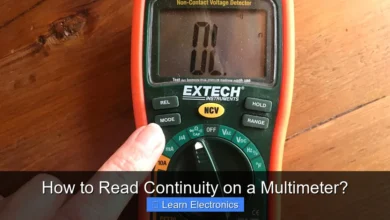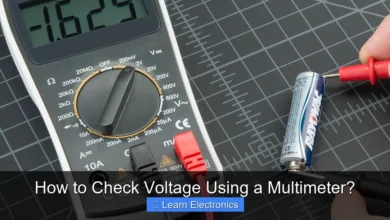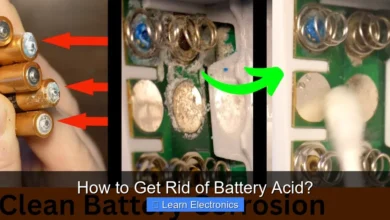How to Measure Capacitor with Multimeter?

As an Amazon Associate, I earn commission from qualifying purchases.
How to Measure Capacitor with Multimeter? This essential electronics skill allows you to diagnose faulty components and verify new ones with accuracy. Mastering this technique can save you time and money, making it a valuable addition to any electronics enthusiast’s toolkit.
This guide will walk you through the process, from preparing your capacitor and multimeter to interpreting the readings, ensuring you have a comprehensive understanding of capacitor measurement.
Quick Answers to Common Questions
Can my regular multimeter measure capacitance?
Not all multimeters have the capability for how to measure capacitor with multimeter. You’ll need a digital multimeter (DMM) that specifically includes a capacitance setting, usually indicated by an ‘F’ (Farad) symbol or its subdivisions (nF, µF, pF).
Do I need to do anything to the capacitor before testing it?
Yes, always discharge the capacitor completely before attempting to measure it to prevent damaging your multimeter or getting an inaccurate reading. Safety first when learning how to measure capacitor with multimeter!
Which setting on my multimeter should I use for capacitance?
To properly measure capacitor with multimeter, turn the dial to the capacitance function, which is often denoted by an ‘F’ or a capacitor symbol. If your multimeter isn’t auto-ranging, start with a range higher than the capacitor’s stated value.
📑 Table of Contents
- Understanding Capacitors and Why Measurement Matters
- Types of Multimeters and Their Capacitance Capabilities
- Essential Preparations Before Testing
- How to Measure Capacitor with Multimeter: A Step-by-Step Guide
- Advanced Techniques and Troubleshooting Tips
- Practical Applications and Best Practices
- Conclusion
Understanding Capacitors and Why Measurement Matters
Before diving into the measurement process, it’s crucial to understand what a capacitor is and why accurately checking its value is so important in electronics.
What is a Capacitor?
A capacitor is a passive electronic component that stores electrical energy in an electric field. It consists of two conductive plates separated by a dielectric (insulating) material. When a voltage is applied across the plates, an electric charge builds up, allowing the capacitor to store energy. Capacitors are vital in nearly every electronic circuit, performing functions like filtering noise, coupling signals, timing, and power supply smoothing.
Importance of Accurate Capacitance Measurement
Accurate capacitor measurement is critical for several reasons:
- Troubleshooting: Capacitors are common points of failure in electronic devices. A bulging, leaky, or out-of-spec capacitor can cause anything from flickering screens to complete device failure. Measuring its capacitance helps confirm if it’s the culprit.
- Component Verification: When building or repairing circuits, it’s good practice to verify that new components match their specified values, especially with cheaper, less reliable parts.
- Circuit Design: For hobbyists and professionals designing circuits, precise capacitance values are often necessary for proper circuit operation, particularly in timing and filter applications.
Types of Multimeters and Their Capacitance Capabilities
Not all multimeters are created equal when it comes to measuring capacitance. Understanding your multimeter’s capabilities is the first step.
Basic Digital Multimeters (DMMs)
Many entry-level digital multimeters offer basic functions like voltage, current, and resistance measurement. Some may include a simple diode test or continuity check. These basic DMMs typically do not have a dedicated capacitance measurement function. While you might be able to infer some information about a capacitor’s health using a resistance setting (which we’ll discuss as a preliminary check), you won’t get an accurate capacitance value.
Advanced DMMs with Capacitance Function
Most mid-range to high-end digital multimeters come equipped with a dedicated capacitance measurement function, usually indicated by a capacitor symbol (a horizontal line over a dashed horizontal line) or “F” for Farads. These are the multimeters you’ll want to use for accurate readings. They often have multiple ranges (e.g., nF, µF) to measure various capacitor sizes.
Analog Multimeters
Analog multimeters use a needle and a scale for readings. While excellent for showing trends and quick checks, they are generally not suitable for measuring capacitance directly. You might be able to use their resistance range to see if a capacitor charges and discharges (indicating it’s not a dead short or open), but they won’t provide an actual Farad value.
Essential Preparations Before Testing
Before you even touch your multimeter probes to a capacitor, there are crucial safety and procedural steps to follow.
Safety First: Discharging Capacitors
This is arguably the most critical step. Large capacitors, especially those in power supplies, camera flashes, or high-voltage circuits, can store significant charges long after power is removed. Touching a charged capacitor can result in a painful shock or even be lethal.
Always discharge a capacitor before handling or measuring it.
To discharge safely:
- Ensure the circuit is completely disconnected from its power source.
- Use a resistor (e.g., 1kΩ to 10kΩ, 5W or higher for large capacitors) with insulated leads to bridge the capacitor’s terminals. This slowly dissipates the charge.
- Alternatively, many multimeters with capacitance functions will automatically discharge small capacitors when connected, but do not rely on this for large, high-voltage caps.
- Confirm the discharge with a voltmeter across the terminals; the reading should be near 0V.
Identifying Capacitor Markings
Before measuring, identify the capacitor’s nominal value and voltage rating. These are usually printed on its body. Capacitance is measured in Farads (F), but you’ll more commonly see:
- Microfarads (µF or uF): 10-6 F
- Nanofarads (nF): 10-9 F
- Picofarads (pF): 10-12 F
Also note the voltage rating. Never use a capacitor in a circuit where the voltage exceeds this rating. For electrolytic capacitors, observe the polarity markings (usually a stripe or a minus sign indicating the negative lead).
Setting Up Your Multimeter
If your multimeter has a capacitance function, follow these steps:
- Turn off the multimeter before connecting probes to avoid surges.
- Insert the test leads: Typically, the red lead goes into the VΩmA or capacitance jack, and the black lead into the COM (common) jack. Some multimeters have a dedicated capacitance jack.
- Select the capacitance mode: Rotate the dial to the capacitance symbol (often a capacitor icon or labeled “CAP” or “F”).
- Choose the appropriate range: If your multimeter doesn’t auto-range, select a range higher than the capacitor’s expected value (e.g., for a 10µF capacitor, select the 20µF or 200µF range). If you don’t know the value, start with the highest range and work your way down until you get a stable reading.
How to Measure Capacitor with Multimeter: A Step-by-Step Guide
With preparations complete, you’re ready to perform the actual measurement. This process assumes you are using a digital multimeter with a dedicated capacitance function.
Discharging the Capacitor
As stressed, always start by ensuring the capacitor is fully discharged. Use a discharge tool or resistor, then verify with a voltmeter if it’s a large capacitor. For small caps (pF, nF, small µF), the multimeter itself will often discharge them when connected, but it’s a good habit to ensure it’s uncharged first.
Connecting the Probes
- Carefully connect the multimeter’s red (positive) probe to one terminal of the capacitor and the black (negative) probe to the other.
- For polarized capacitors (electrolytic and tantalum), ensure you connect the red probe to the positive (+) terminal and the black probe to the negative (-) terminal. Incorrect polarity can damage the capacitor or lead to inaccurate readings.
- For non-polarized capacitors (ceramic, film), the connection order doesn’t matter.
Taking the Measurement
Once the probes are connected, the multimeter will begin its measurement cycle. This might take a few seconds, especially for larger capacitors, as the multimeter internally charges and discharges the capacitor to determine its value. Wait for the reading on the display to stabilize.
Interpreting the Readings from Your Multimeter Capacitor Test
The reading displayed on your multimeter is the measured capacitance value, usually in Farads (F), microfarads (µF), nanofarads (nF), or picofarads (pF).
- Comparing to Nominal Value: The measured value should be close to the capacitor’s labeled value. Keep in mind that capacitors have a tolerance, typically ±5%, ±10%, or ±20%. So, a 10µF capacitor with ±10% tolerance should read anywhere between 9µF and 11µF.
- Open Circuit: If the multimeter displays “OL” (Over Load), “OV” (Over Range), or an unstable reading that eventually goes to zero for a non-auto-ranging meter, the capacitor is likely “open” (internal break), meaning it cannot store charge.
- Short Circuit: If the multimeter immediately shows a very low or zero reading, the capacitor might be “shorted” (internal connection between plates), preventing it from holding any charge.
- Fluctuating Readings: Unstable or highly fluctuating readings could indicate an intermittent fault or a capacitor that’s failing.
Advanced Techniques and Troubleshooting Tips
While a standard multimeter provides capacitance, more advanced aspects might require specific techniques or specialized equipment.
Testing Polarity for Electrolytic Capacitors
As mentioned, electrolytic capacitors are polarized. They have a positive and a negative lead. The negative lead is usually marked with a stripe or a minus sign. Always connect your multimeter’s positive lead to the capacitor’s positive terminal and the negative lead to the negative terminal. Incorrect connection can damage the capacitor and give false readings.
Common Measurement Problems and Solutions
- No Reading / OL / Open Circuit:
- Check if the capacitor is truly open by trying another known good capacitor.
- Ensure proper connection of probes.
- Verify your multimeter is on the correct range.
- Very Low / Zero Reading / Short Circuit:
- The capacitor is likely shorted internally.
- Ensure the capacitor is completely discharged before testing; residual charge can sometimes temporarily short the meter.
- Inconsistent or Fluctuating Readings:
- This often indicates a failing capacitor.
- Ensure probes are making firm contact.
- External interference or a faulty multimeter can also cause this.
- Reading Far Off Nominal Value:
- Check the capacitor’s tolerance.
- Consider the capacitor’s age; older capacitors can drift in value.
- It might be faulty and needs replacement.
Using the Resistance (Ohm) Function for a Quick Check (Limited)
Even if your multimeter lacks a capacitance function, you can perform a very basic check using the resistance setting, especially for larger electrolytic capacitors. This method won’t give you a Farad value but can indicate if the capacitor is completely dead (shorted or open).
- Discharge the capacitor.
- Set your multimeter to a high resistance range (e.g., 200kΩ or 2MΩ).
- Connect the probes to the capacitor’s terminals (observing polarity for electrolytics).
- Observe the reading:
- Initially, the resistance should be low and then gradually increase, eventually going to “OL” or infinity as the capacitor charges from the multimeter’s internal battery. This indicates it’s likely functional.
- If it immediately shows “OL” and stays there, the capacitor is likely open.
- If it stays at a very low resistance (near 0Ω), the capacitor is likely shorted.
This method is more qualitative than quantitative and is not suitable for small capacitors (pF or nF) or highly accurate checks.
Practical Applications and Best Practices
Knowing how to measure capacitor with multimeter empowers you in various electronics endeavors. Here are some practical scenarios and best practices.
When to Replace a Capacitor
You should consider replacing a capacitor if:
- Its measured capacitance is outside its specified tolerance range.
- It shows physical signs of damage, such as bulging, leaking electrolyte, or a burnt appearance.
- It fails the quick resistance check (shorted or open).
- It’s suspected of causing circuit malfunction, even if its capacitance measures within tolerance (sometimes ESR is the issue, which a basic multimeter cannot test).
Verifying New Components
Even new components can sometimes be faulty or incorrectly labeled. Performing a quick capacitance check on new capacitors before soldering them into a circuit can prevent frustrating troubleshooting later on. This is especially true for components from less reputable sources.
Long-Term Maintenance Tips
- Keep a log: For critical circuits, keeping a log of capacitor values over time can help predict failures.
- Proper storage: Store capacitors in a cool, dry place. Electrolytic capacitors, if stored for very long periods (years) without power, might need “reforming” before use.
- Visual inspection: Always combine your multimeter measurements with a thorough visual inspection for any physical signs of damage.
Here’s a quick reference table for common capacitor types and their general characteristics:
| Capacitor Type | Polarized? | Typical Capacitance Range | Common Applications |
|---|---|---|---|
| Electrolytic | Yes | 1 µF to 1 F | Power supply filtering, audio coupling |
| Ceramic | No | 1 pF to 0.1 µF | High-frequency decoupling, resonant circuits |
| Film (Mylar, Polyester) | No | 1 nF to 10 µF | Timing circuits, filters, audio coupling |
| Tantalum | Yes | 0.1 µF to 100 µF | Switching power supplies, precision timing |
Conclusion
Learning how to measure capacitor with multimeter is an invaluable skill for anyone working with electronics. It’s a fundamental aspect of diagnostics, repair, and even design. By understanding the types of capacitors, preparing safely, correctly setting up your multimeter, and accurately interpreting the readings, you can confidently assess the health and value of these critical components. Always prioritize safety, especially when dealing with potentially charged capacitors, and remember that even a basic check can prevent significant headaches down the line. Keep practicing this method, and you’ll quickly become proficient in identifying faulty capacitors and maintaining your electronic devices.
Frequently Asked Questions
What multimeter setting do I use to measure a capacitor?
You’ll need a digital multimeter with a dedicated capacitance mode, often indicated by a symbol like “nF” (nanofarads), “µF” (microfarads), or “mF” (millifarads) on the dial. Select this setting, usually in conjunction with a range, to accurately measure the capacitor’s value. If your multimeter lacks this specific function, it cannot directly measure capacitance.
Do I need to discharge a capacitor before measuring it with a multimeter?
Yes, absolutely. Always discharge a capacitor before handling or measuring it with a multimeter, especially large electrolytic ones. Capacitors can store significant electrical charges even after power is removed, posing a shock hazard and potentially damaging your multimeter if not properly discharged through a resistor.
How can I tell if a capacitor is bad using a multimeter?
A bad capacitor will often show a capacitance reading significantly lower than its labeled value, or no reading at all. For electrolytic capacitors, visual signs like bulging, leakage, or burn marks are strong indicators of failure. Advanced multimeters with an ESR function can also reveal a high Equivalent Series Resistance, which points to a faulty capacitor.
Does polarity matter when measuring a capacitor with a multimeter?
Polarity is crucial for electrolytic capacitors, which are polarized and have distinct positive and negative terminals. When testing these, connect your multimeter’s positive lead to the capacitor’s positive terminal and the negative lead to its negative terminal. For non-polarized capacitors, such as ceramic or film types, polarity does not matter.



